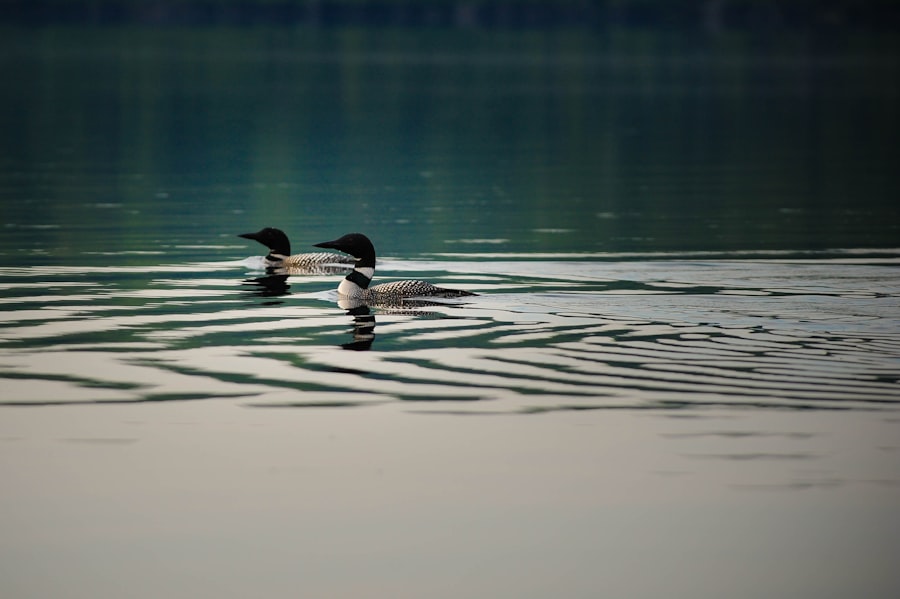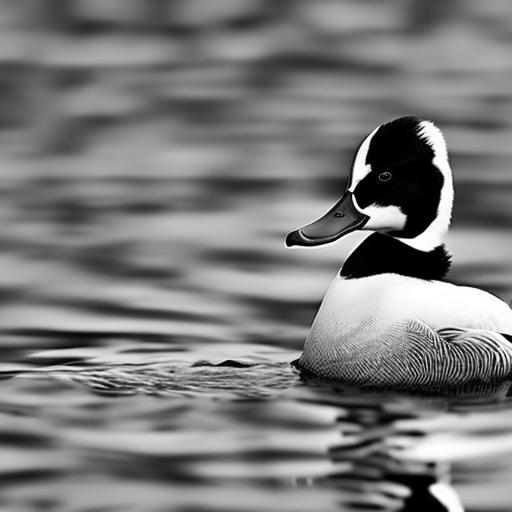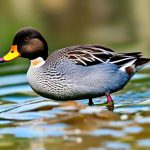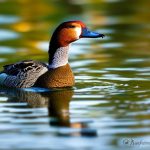Black and white domestic duck breeds are a popular choice among duck enthusiasts for their striking appearance and unique characteristics. These ducks are known for their beautiful plumage, which consists of black and white feathers that create a contrasting pattern. They are often sought after for their aesthetic appeal and are commonly kept as pets or for exhibition purposes.
Key Takeaways
- Black and white domestic duck breeds are popular for their unique and striking appearance.
- Physical characteristics of black and white ducks include a variety of patterns and color combinations, as well as a medium-sized body and webbed feet.
- The history and origins of black and white duck breeds can be traced back to ancient China and Europe.
- Popular black and white duck breeds include the Magpie, the Cayuga, and the Ancona.
- Breeding and rearing black and white ducks requires careful attention to genetics, nutrition, and housing conditions.
Physical Characteristics of Black and White Ducks
Black and white ducks are easily recognizable by their distinct coloration. They typically have a black body with white markings on their head, neck, chest, and wings. The pattern of the white markings can vary between breeds, with some ducks having more extensive white areas than others.
In terms of size, black and white ducks are generally medium to large in size. They have a compact body shape with a rounded head and a medium-length neck. Their legs are set far back on their bodies, which allows them to swim easily in water.
There are also differences between male and female black and white ducks. Males, known as drakes, are usually larger than females, known as hens. They also have more vibrant plumage, with brighter colors and more pronounced markings. Females tend to have more subdued colors and markings.
History and Origins of Black and White Duck Breeds
The origins of black and white duck breeds can be traced back to various parts of the world. Some breeds have been developed through selective breeding over many generations, while others have naturally occurred in the wild.
One of the most well-known black and white duck breeds is the Magpie duck, which originated in England in the early 20th century. It was developed by crossing various breeds, including the Runner duck and the Rouen duck. The goal was to create a breed with attractive black and white plumage that also had good egg-laying abilities.
Another popular black and white duck breed is the Cayuga duck, which is believed to have originated in North America. It is named after Cayuga Lake in New York, where it was first bred. The Cayuga duck is known for its iridescent black feathers, which can have a greenish sheen in certain lighting conditions.
Popular Black and White Duck Breeds
There are several black and white duck breeds that are popular among duck enthusiasts. Each breed has its own unique characteristics and traits that make it desirable.
The Magpie duck is a medium-sized breed with a calm and friendly temperament. It is known for its striking black and white plumage, which is evenly distributed across its body. Magpie ducks are good layers of large white eggs and are also valued for their meat.
The Cayuga duck, as mentioned earlier, is known for its beautiful iridescent black feathers. It is a medium-sized breed with a calm and docile nature. Cayuga ducks are good layers of medium-sized eggs and are also valued for their meat.
Another popular black and white duck breed is the Ancona duck, which originated in Italy. It has a mottled black and white plumage that gives it a speckled appearance. Ancona ducks are known for their excellent egg-laying abilities and are also valued for their meat.
Breeding and Rearing Black and White Ducks
Breeding black and white ducks requires careful selection of breeding stock to ensure the desired coloration and traits are passed on to the offspring. It is important to choose ducks with good conformation, health, and temperament.
To breed black and white ducks, it is recommended to keep a ratio of one drake to four or five hens to prevent overbreeding. The drake should be introduced to the hens gradually to minimize aggression. The eggs should be collected daily and stored in a cool place until ready to be incubated or placed under a broody hen.
Rearing black and white ducklings is relatively straightforward. They should be kept in a warm and dry brooder with access to clean water and a balanced diet. Ducklings should be fed a high-quality starter feed that is specifically formulated for ducks. They should also be provided with a shallow dish of water for swimming and grooming.
Feeding and Nutrition for Black and White Ducks

Black and white ducks have similar nutritional requirements to other duck breeds. They should be fed a balanced diet that consists of a combination of commercial feed, fresh vegetables, and protein sources.
A good quality commercial duck feed should make up the majority of their diet. It should contain the necessary vitamins, minerals, and protein to support their growth and overall health. Fresh vegetables such as lettuce, spinach, and peas can be offered as treats to provide additional nutrients.
Protein is an important component of a duck’s diet, especially during the breeding season. It can be provided in the form of insects, worms, or cooked meat scraps. It is important to ensure that any protein sources offered are safe for ducks to consume.
Housing and Care for Black and White Ducks
Black and white ducks require appropriate housing to keep them safe and comfortable. They should have access to a secure enclosure or coop that protects them from predators and the elements.
The housing should be spacious enough to allow the ducks to move around freely. It should also have adequate ventilation to prevent the buildup of moisture and ammonia from their droppings. Bedding material such as straw or wood shavings should be provided to keep the ducks dry and comfortable.
Ducks also need access to clean water for drinking, bathing, and swimming. A shallow pool or pond can be provided for this purpose. It is important to regularly clean and refill the water to prevent the spread of diseases.
Health and Diseases of Black and White Ducks
Black and white ducks are generally hardy and resilient, but they can still be susceptible to certain health issues and diseases. It is important to monitor their health regularly and take appropriate measures to prevent and treat any problems that may arise.
Common health issues in black and white ducks include respiratory infections, parasites, and foot problems. Respiratory infections can be caused by poor ventilation or exposure to cold and damp conditions. Parasites such as mites and worms can cause discomfort and affect the ducks’ overall health. Foot problems, such as bumblefoot, can occur if the ducks are kept on hard or rough surfaces.
To prevent health issues, it is important to provide a clean and dry environment for the ducks. Regular cleaning of their housing and bedding is essential. Ducks should also be provided with a balanced diet and access to clean water at all times.
If a duck does become sick, it is important to seek veterinary advice as soon as possible. Early detection and treatment can greatly improve the chances of a full recovery.
Uses of Black and White Ducks
Black and white ducks have various uses in agriculture and farming. They are often kept for their meat, eggs, or as pets.
The meat of black and white ducks is known for its rich flavor and tenderness. It is often used in gourmet dishes and is highly valued by chefs. The meat can be roasted, grilled, or used in soups and stews.
Black and white ducks are also good layers of eggs. The eggs are typically larger than chicken eggs and have a rich yolk. They can be used in baking or cooking, or simply enjoyed as a nutritious breakfast.
In addition to their culinary uses, black and white ducks are also kept as pets or for exhibition purposes. Their striking appearance makes them popular among duck enthusiasts who appreciate their beauty.
Conclusion and Future of Black and White Duck Breeds
In conclusion, black and white domestic duck breeds are popular among duck enthusiasts for their striking appearance and unique characteristics. They have a distinct coloration and are known for their beautiful plumage.
Black and white ducks have a rich history and have been developed over time through selective breeding. They come in various breeds, each with its own unique traits and characteristics.
Breeding and rearing black and white ducks require careful selection of breeding stock and proper care of the ducklings. They have similar nutritional requirements to other duck breeds and should be provided with a balanced diet.
Black and white ducks require appropriate housing and care to keep them safe and healthy. Regular monitoring of their health is important to prevent and treat any issues that may arise.
Black and white ducks have various uses in agriculture and farming, including meat production, egg-laying, and as pets or exhibition birds.
Overall, black and white duck breeds have a bright future in the duck community due to their aesthetic appeal and versatility. They will continue to be valued for their beauty, as well as their meat and eggs.
If you’re interested in black and white domestic duck breeds, you might also enjoy reading about the fascinating mating season of ducks. Understanding when duck mating season occurs can be helpful for breeders and enthusiasts alike. To learn more about this topic, check out this informative article on Poultry Wizard: When is Duck Mating Season?
FAQs
What are black and white domestic duck breeds?
Black and white domestic duck breeds are a group of duck breeds that have black and white feathers. These breeds are commonly kept as pets, for meat, or for egg production.
What are some examples of black and white domestic duck breeds?
Some examples of black and white domestic duck breeds include the Magpie, the Ancona, the Cayuga, and the Welsh Harlequin.
What is the size of black and white domestic duck breeds?
The size of black and white domestic duck breeds varies depending on the breed. Some breeds are small, weighing around 2-3 pounds, while others can weigh up to 10 pounds.
What is the lifespan of black and white domestic duck breeds?
The lifespan of black and white domestic duck breeds varies depending on the breed and the care they receive. On average, domestic ducks can live up to 10 years.
What is the temperament of black and white domestic duck breeds?
The temperament of black and white domestic duck breeds varies depending on the breed and the individual duck. Some breeds are known to be more docile and friendly, while others can be more aggressive.
What is the purpose of keeping black and white domestic duck breeds?
Black and white domestic duck breeds are kept for a variety of purposes, including as pets, for meat production, and for egg production. Some breeds are also used for exhibition or showing.
Meet Walter, the feathered-friend fanatic of Florida! Nestled in the sunshine state, Walter struts through life with his feathered companions, clucking his way to happiness. With a coop that’s fancier than a five-star hotel, he’s the Don Juan of the chicken world. When he’s not teaching his hens to do the cha-cha, you’ll find him in a heated debate with his prized rooster, Sir Clucks-a-Lot. Walter’s poultry passion is no yolk; he’s the sunny-side-up guy you never knew you needed in your flock of friends!







